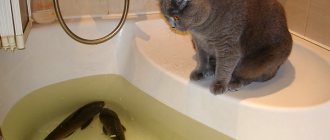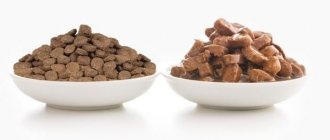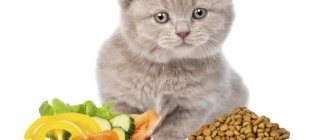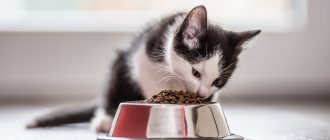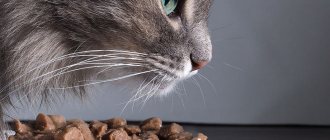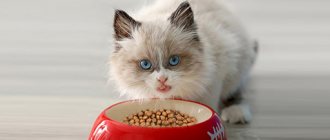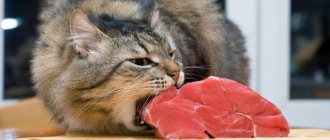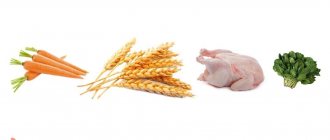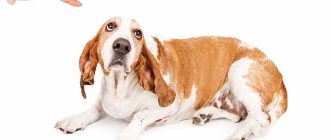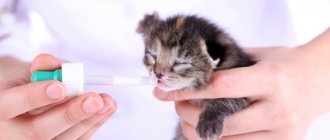With the arrival of a kitten in the house, the owner has many worries. What to bathe, when to take to the veterinarian, what diet to choose - natural or industrial. These and many other issues require urgent decisions. When choosing dry or wet food for cats, it is important to remember that the animal is a predator in nature and its stomach is adapted to digest raw meat and fish. Therefore, the main thing is not the consistency of the diet, but its composition.
Features of feeding kittens
A kitten's diet is radically different from that of adults. He needs the whole complex of vitamins and microelements. As it grows, all vital organs and systems are formed, and a lack of the necessary components will negatively affect health.
A kitten's diet is radically different from that of adults.
For up to 2 weeks, it is recommended to take purely breast milk substitutes, which are sold in pet stores. If they are not available, you can prepare the mixture yourself by combining 4 parts goat or cow milk with 1 part egg white.
As you grow, this nutrition will not be enough. In the 3rd week you need to introduce additional ingredients into the diet. As a supplement, you need to use canned food and dry mixtures for kittens of the premium and super-premium categories.
Meals should be chosen depending on age; this information should be checked with the seller or found on the packaging. It is recommended to combine them with dairy nutrition: 30% is feed, 70% is dairy nutrition.
Advice! You should not purchase cheap products, as they provoke the development of diseases.
Age when you can switch to regular food
It is recommended to completely switch to regular food for the younger age category at 1 month. Formula milk should also continue to be given, but in a smaller dosage. And by 2 months the kitten should be switched to the main type of food. This transition will help avoid stress for your pet.
It is worth changing the product line only as a last resort.
Completeness and balance
For constant nutrition, food must contain all the nutrients it needs, macro- and microelements, vitamins and fiber. Almost all dry food on the market is complete in composition, but the same cannot be said about wet food. Among them there are a lot of products intended for additional nutrition, in other words, treats, and they cannot provide a balanced diet.
If we take for comparison dry and wet food, declared by the manufacturer as complete food, then what we have already called the main criterion comes to the fore - the composition of the product. And here the requirements are the same: food for cats and dogs as carnivores must be based on meat, and the higher the amount of meat ingredients, the better. In this sense, high-quality dry food, consisting of 75%–85% of various sources of animal protein, is definitely healthier than some canned food, which contains practically no meat.
In order to understand all this, you need to look not at the beautiful pictures and inscriptions on the packages, but at the list of ingredients, from which it immediately becomes clear how much meat actually is in the product.
Food selection for an adult
When choosing natural food, the cat owner should focus on the needs of the animal.
There are 2 food options for an adult pet: ready-made dry/wet ingredients and natural food. Which one to choose, everyone decides for themselves, depending on personal preferences.
But veterinarians advise purchasing finished products that contain all the necessary substances in an accessible form. At the same time, you can diversify your diet with both dry mixture and wet food. The main thing is to choose premium and super-premium products.
You can judge the beneficial properties of a particular product by the condition of the coat (smooth, shiny) and the activity of the animal.
When choosing natural food, the cat owner should focus on the needs of the animal, depending on its age and breed.
Also keep in mind that the diet should include not only meat, but also cereals, vegetable oils, dairy products, vegetables, fish, and eggs.
Be sure to read:
Is it possible to feed a cat dry food and natural food at the same time: pros and cons, which is better?
Advantages and disadvantages of wet food
Animals like wet diets more - this is an immutable truth, tested by many breeders. The consistency of such food is closer to the natural diet and, due to the presence of moisture in it, it has a brighter aroma.
Pros:
- A wet diet contains a lot of protein and fats, which are necessary for the animal's health and beautiful coat.
- Each product package contains up to 75% of the moisture a cat needs for healthy digestion.
- Allows you to eliminate overeating as a result of being saturated with protein and quickly induces a feeling of fullness.
- Pets like the aroma and taste of wet food; they eat the offered portion with appetite, regardless of their mood and health status. Canned food is recommended for those animals that eat little and reluctantly.
Minuses:
- The product is more expensive and not as economical as granular.
- It is not sold in large quantities, as it quickly deteriorates when opened.
- Causes an unpleasant odor from the animal’s mouth as a result of the formation of bacterial plaque, and with constant use it provokes diseases of the teeth and gums.
What should you not feed your cat?
There are certain foods that are strictly forbidden to give to a cat. When planning your diet, you should completely exclude them.
You should not give your pet:
- fatty meat (pork, lamb);
- sweets and sugar analogues;
- spices;
- smoked meats, marinades;
- onion garlic;
- sour foods;
- fried food;
- sausages, sausages;
- fatty fish.
Attention! When preparing natural food, you should not add salt and spices, because... this leads to liver and kidney dysfunction.
Canned food
Manufacturers delight with a variety of canned food for dogs. It can be pate, pieces of meat in sauce, or regular stew. This food is called wet food. These dog foods are very popular. Why do owners of four-legged animals choose canned food? And why do eared-tailed creatures happily gobble up food from cans? Let's figure it out:
- wet food contains a large amount of moisture. Therefore ideal for travel. It partially replaces the animal's drinking;
- It is appropriate to feed your dog canned food if the pet has no problems digesting regular food. Wet canned food is quickly and easily digested;
- they have a pleasant aroma and, as manufacturers say, excellent taste. That's why dogs like them.
Feeding dogs canned food gives positive results in combination with feeding pellets. By itself, wet canned food is not able to clean tartar from a dog’s teeth, but in combination with porous pads the desired effect is achieved.
What disadvantages do owners notice when their pets eat food from a can? The most frequently discussed disadvantages are:
- wet dog food is addictive. Therefore, if your miracle suddenly refuses to eat boiled meat or turns its nose up at cottage cheese, do not be surprised. If you do not intend to feed your animal canned dog food constantly, do not resort to this type of food too often;
- Canned dog food is unreasonably expensive. The bulk of the products contain no more than 30% natural meat. That is, the nutritional value of the product is low.
How can you tell if you have good canned food? Take a look at what the manufacturer says in the ingredients. It is important that specific types of meat and offal are indicated. In this case, you can be sure of the quality of the product. Avoid dog food that contains dyes and artificial flavors.
Feed classification
All ready-made mixtures are divided into certain categories depending on quality, composition, usefulness and pricing policy. To understand the difference, it is worth familiarizing yourself with all types separately.
Economy class
Economy class food for cats
These products are the most affordable . Its function is the ability to quickly satisfy hunger, filling the stomach, but it cannot be considered as the main food.
Economy class is comparable to the fast food that a person uses. It allows you to fill your stomach and give you a feeling of fullness, but has practically no beneficial properties.
In the production of this category, by-products, soybeans and a large number of grains are used. To ensure that food has an appetizing smell and taste, flavorings, flavor enhancers and colorings are added to it.
Popular representatives:
- Kitikat;
- Whiskas;
- Friscas;
- Felix;
- Oscar.
Important! This category does not provide any benefit to the body, so veterinarians do not recommend using it as the basis of the diet due to the low protein content and vitamin complex supplements.
Middle class
This line surpasses economy class in its useful qualities. The feed contains by-products, but of high quality. The volume of soybeans and grains used in production has been significantly reduced.
The content of flavors and other harmful additives is minimized. The calorie content of the product is higher due to better digestibility of the incoming substances. This allows the daily consumption rate to be significantly reduced.
Manufacturers:
- Cat Chow;
- Karma Organic;
- Perfect Fit.
The label of medium category products must contain the following information:
- protein content (at least 25%) and its source of origin (specific name of meat);
- the presence of fish and liver, which are a source of vitamin A, E;
- daily consumption rate (the lower this figure, the better);
- concentration of by-products, cereals, soy and chemicals (no more than 50%);
- best before date;
- the abbreviation AAFCO, which confirms the passage of quality control.
If this information is not on the packaging, then it is not worth buying the product.
Premium class
This category differs in meat content, but does not exclude the presence of offal and vegetable protein. During production it is enriched with vitamins and microelements, which significantly improves the benefits of its use.
When purchasing, you should pay attention to the content of rice, grains and corn grits. The higher their content, the lower the quality.
Manufacturers:
- Nutro Choice;
- Royal Canin;
- Eukanuba;
- Bozita.
When choosing a premium class, owners can expect that this product will not cause harm to health, and the benefits will be tangible. This property explains the popularity of premium products.
Super premium class
This category refers to high quality types. It contains meat, fish and all useful components for full development.
Be sure to read:
How to feed a cat if he doesn’t eat, what to feed a sick cat
No chemical components that improve taste and smell are introduced during production. All components included in the product are clearly indicated on the packaging. It is impossible to find anything unnecessary, as the product undergoes strict quality control.
The reduction in daily intake is achieved by a high percentage of components digestibility. This justifies the cost of the super-premium category, since to replenish the pet’s strength it is enough to eat a small amount of food.
Manufacturers;
- Nutram;
- Arden Grange;
- Brit Care;
- Acana;
- Farmina N&D.
The history of cat food
The friendship between cats and humans began with mutually beneficial cooperation back in the 19th century. While stockpiling grain, people were faced with an invasion of rodents that spoiled the harvest and spread terrible infectious diseases, such as the plague.
The cats came on their own, from nowhere, significantly reducing the number of rats and mice. In gratitude for the help, people began to feed the animals, keep them in their homes, and care for them. The pets happily accepted the conditions.
By the mid-19th century, rusks for feeding dogs were invented. This inexpensive product saved time on preparing food for dogs and was easy to use. The innovation quickly spread, and pet food could be found in the basket of the average Englishman leaving the store.
The year 1930 was marked by the release of the first canned meat for cats. The animals appreciated the invention and happily switched to tasty and healthy diets.
Literally a few years later, the war began and all the metal used by people in everyday life was sent for the production of weapons. In reality, no one was going to give up such a profitable business as producing animal diets. By 1946, dry cat food packaged in regular paper bags was widely used.
Ease of use, low cost, long shelf life and balanced composition have made the product popular in a matter of years.
Dry mixes
This type of food is most popular due to the preservation of nutritional properties for a long time. It is convenient because you can pour it in once every few days without worrying about the food spoiling.
Be sure to place a bowl of clean water near the feeder, since a lack of moisture in food provokes increased thirst.
Crispy pieces are useful not only for their composition, but also for their ability to clean plaque from teeth. Store reserves of the dry mixture in closed packaging, since prolonged contact with air reduces the beneficial properties.
Cleaning teeth
This is a controversial issue: some veterinary experts believe that dry food helps clean teeth from plaque, others argue that the contact of the enamel surface with the granule is so short-lived, and the granule itself crumbles so quickly that dry food does not bring any particular benefit in this sense . We believe that it is still better to use special treats with a viscous texture to clean your teeth.
As for wet food, of course, they cannot mechanically clean teeth, and therefore owners need to take preventive measures to maintain the pet’s oral health.
Which diet is better: wet or dry?
It is impossible to answer this question unequivocally, because a pet needs variety in its diet and nutritional components. The best option is a combination of these types of food, but of the same category.
Veterinarians recommend using wet food for breakfast and dinner, and adding dry food during the day. This will allow you to achieve optimal balance in your diet.
Which diet is better: wet or dry?
Water content
This is the main difference between dry and wet diets: the former contain very little moisture - less than 10%, the latter are close in content to natural, natural food for animals, and consist of approximately 70% water. Therefore, as a rule, dogs and cats eat wet food more readily than dry food - they are more familiar with such food, but the level of humidity does not affect the digestibility or supply of useful nutrients.
The only caveat: if you choose dry food for your pet, you need to carefully ensure that it drinks a lot, especially for cats. However, if you have provided your pet with constant access to clean, fresh water, there is no need to worry about the consequences associated with insufficient fluid entering the body.
Natural food for cats
When choosing natural products, you need to focus on the needs of the animal. This depends on his level of health, age, breed and activity level.
This diet should include:
- low-fat fermented milk products;
- boiled meat of lean varieties;
- high-quality offal (liver, heart, stomachs);
- vegetables, greens of neutral taste;
- lean fish without bones;
- vegetable oils;
- cereals;
- egg yolks.
The diet should be supplemented with vitamins and minerals depending on the time of year, breed and age. These components should be administered on the recommendation of a veterinarian in accordance with the indicated dosage. It is important to use healthy supplements in the autumn and spring.
Reviews from veterinarians about food
Hello, I can recommend FarminaMonge for good food, although Royal Canin is also a good food. If your pet continues to have inflammation in the gastrointestinal tract, then you can use Gaster food for life, or if a food allergy is confirmed, then the appropriate food.
Irina Sergeevna Startseva
https://www.zoovet.ru/forum/?tid=7&tem=1069331
The kitten only needs food for KITTENS!!! Strictly by weight + water (Royal Canin, Hills, Pro Plan or Eukanuba).
vczd
https://www.veterinarka.ru/forum/t19552.html
Feed rating
Of the entire variety of products, several stand out whose price and benefit indicators are acceptable. Using them as the basis of nutrition allows you not to worry about your pet’s well-being.
Rating of the most useful types:
- Orijen - animal protein content - 42%.
- Acana - high concentration of fish and poultry fats.
- NOW Natural - increased content of fish oil.
- Bosch SANABELLE - the basis is dietary poultry and fish.
- 1st Choice - protein content - 28-30%, based on rabbit, fish, poultry meat.
- Arden Grange - 25-26% vegetable components, the rest is meat, also contains dried egg.
- Hill's - main ingredients: beef, poultry, rabbit.
- Royal Canin - contains animal and plant proteins.
Be sure to read:
When to start feeding kittens: how to introduce them, diet, what not to feed, age for first feeding
Note to the owner
- The best food for kittens is one with a high meat content, and it doesn't really matter whether it's dry or wet.
- The animal must have access to fresh drinking water around the clock, this is especially important when using dry diets.
- Try to feed the kitten at the same hours, choosing a quiet and secluded place for this, located far enough from the tray.
- You cannot give kittens wet food in excess of dry food: you need to reduce the recommended amount of each by half (50 to 50%) or in another convenient proportion (60 to 40%, 70 to 30%, and so on).
Composition analysis
When choosing, you need to carefully study the composition of the product. It should contain useful components to the maximum, and harmful ones - in minimal quantities.
Substances indicated in the composition, the presence of which is undesirable:
- sugar, its analogues:
- dye E12, which increases the likelihood of the formation of malignant tumors;
- high content of harmful by-products (skin, feathers, beaks);
- meat without indicating its source;
- antioxidants that damage the liver: E320, 324, 321;
- flavorings;
- flavor enhancers.
The quality of nutrient mixtures of wet and dry consistency can be recognized if the ratio of healthy products in their composition does not differ significantly from the following indicators:
- meat, with exact indication of name - 35%;
- protein - 20%;
- high quality by-products - 10%;
- plant matter - 25%.
A whole complex of vitamins and mineral components should also be present.
Price
Feeding wet food is more expensive than dry food because, due to the high moisture content, the daily intake is much higher. And if for small breed dogs and cats this difference is not so noticeable, although in this case it certainly exists, then when we talk about the nutrition of a large dog, it becomes critical.
Wanting to save money, some owners mix canned food with boiled cereals, but thereby upset the balance of the diet, shifting it towards increasing carbohydrates that are completely unnecessary for the dog. Because of this, the whole point of eating ready-made industrial diets, which are complete foods, is lost.
We told you about the main disadvantages and advantages of different types of food, and after weighing them, you can answer the question yourself, which food is better, dry or wet, for you personally. We can only repeat from ourselves - the main thing is to choose a high-quality diet with a high content of meat ingredients, which contains all the nutrients your pet needs.
What diet do veterinarians recommend?
There is no convinced opinion that you should use only industrial food or natural food. The main thing is not to combine these two types of nutrition with each other.
But the opinions of professionals are inclined towards the use of ready-made nutritional mixtures, since they have a balanced composition.
Basic nutrition rules:
- Choose premium or super-premium ready-made nutritional products.
- When using dry nutritional mixtures, be sure to place a bowl of clean water nearby.
- Food must have a high level of digestibility.
- Do not mix canned and dry mixtures at the same time.
- You need to select a dry product with small granules.
- Do not pour large portions, as many pets do not have a sense of proportion.
- Use a nutritional product in accordance with the age category.
- Do not mix products of different qualities.
It is important to use not only high-quality food, but also to learn how to use it correctly. Only in this case will the pet be healthy, active, and its coat will become smooth and shiny.
What is the main difference between the feeds?
Before delving into the essence of the title question, it is worth identifying the differences between different types of food.
The appearance, which you probably thought of first, is indeed the key difference. Dry food consists of granules of various sizes, colors and shapes, while wet food consists of soft pieces in sauce or a delicate pate.
In fact, the main difference in this regard is the availability of water. Dry food contains no more than 10% of it, and wet food contains up to 70%. However, if, when feeding granules, the cat is given free access to drinking water (this, by the way, is a mandatory aspect of proper feeding), then the difference between the types of food is almost completely leveled out.
